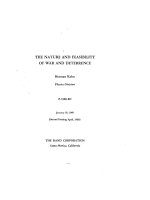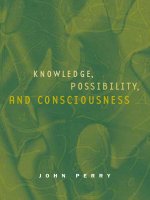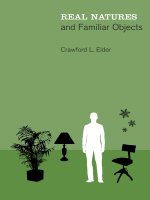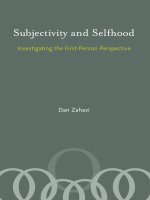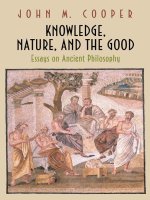the mit press the love of nature and the end of the world the unspoken dimensions of environmental concern dec 2001
Bạn đang xem bản rút gọn của tài liệu. Xem và tải ngay bản đầy đủ của tài liệu tại đây (1.59 MB, 227 trang )
The Love of Nature and the End of the World
This page intentionally left blank
The Love of Nature and the End of the World
The Unspoken Dimensions of Environmental Concern
Shierry Weber Nicholsen
The MIT Press
Cambridge, Massachusetts
London, England
2002 Massachusetts Institute of Technology
All rights reserved. No part of this book may be reproduced in any form by any electronic or mechanical
means (including photocopying, recording, or information storage and retrieval) without permission in writ-
ing from the publisher.
This book was set in Berkeley Old Style Book by Achorn Graphic Services, Inc. on the Miles 33 system.
Printed and bound in the United States of America.
Library of Congress Cataloging-in-Publication Data
Nicholsen, Shierry Weber.
The love of nature and the end of the world : the unspoken dimensions of environmental concern /
Shierry Weber Nicholsen.
p. cm.
Includes bibliographical references and index.
ISBN 0-262-14076-4 (hc. : alk. paper)
1. Human ecology—Philosophy. 2. Environmental degradation—Psychological aspects. I. Title.
GF21 .N53 2001
179′.1—dc21
2001044329
Arden H. Nicholsen
in memoriam
This page intentionally left blank
Contents
Acknowledgments ix
Introduction 1
1 Many Silences 7
2 The Love of Nature and the Concern for Life 35
3 Tangling at the Roots of Being: Perception as Field and
Reciprocity 63
4 What Beauty Can Tell Us: The Face of Nature 95
5 A Severe and Pervasive Apathy: Trauma, Destructiveness,
and the End of the World 129
6 The Future and the Possible 161
Concluding Thoughts 195
Bibliography 201
Name Index 209
Subject Index 213
This page intentionally left blank
Acknowledgments
The stuff of this book is derived in large part from conversations with many
people in many contexts over the past years—friends, colleagues, teachers, and
students; people I have come to know in Seattle’s psychoanalytic community,
in Antioch University’s Environment & Community program, in the arts, and
elsewhere. There are many people to whom I am grateful for very specific con-
tributions, of widely varying kinds, to the book. Among them are Barbara
Barry, Kim Buehlman, Guy Burneko, Judy Cadman, Austin Case, Karen Coffey,
Brian and Pam Costner, Susan Czopek, Francesca de Gasparis, Gene Dilworth,
Jeffrey Eaton, Joan Fabian, Marilan Firestone, Janet Gerard, Raelene Gold,
Terry Hanson, Caron Harrang, E. Lynn Hassan, Kim Hayes, Sally Hufbauer,
Jeffrey Kahane, Katherine Knowlton, Angela Leja, Gaeage Moetse Maher, Peter
Martynowych, Rachel Matthews, Steve Maurer, Betsy McConnell, Joan Mellon,
Marllan Meyer, Randy Morris, Bev Osband, Phillip Penna, Janet Pfunder, Janet
Sailer, Trent Schroyer, Jeremy Shapiro, Chris Slesar, Gene Sterling, Mark
Windschitl, and Sara Winter.
I have been deeply touched by the thoughtfulness and eloquence of the stu-
dents in my environmental philosophy courses. Many will find thoughts and
feelings they expressed reflected here. I am grateful to them all.
My thanks to all the people who read earlier versions of the manuscript and
offered their comments, which were helpful in ways they might never have
anticipated. I am particularly grateful for the exceptionally close readings my
x Acknowledgments
friend Sally Hufbauer and an unnamed reviewer gave the manuscript and the
detailed suggestions they offered.
I owe a special debt to my friend and colleague Stephen G. Shehorn, who
not only graciously allowed me to accompany him on a hunt but also imparted
some of the elegance of his own style to portions of the manuscript he edited.
This book could not have been written without the support and illumination
afforded by my personal psychoanalysis—one of whose aims is to allow the
unspoken to become speakable. For this I am deeply grateful.
The opportunity to present and discuss portions of this material in various
professional settings has been extremely helpful, and I would like to express
my gratitude to the groups and organizations that provided those occasions,
among them Antioch University Seattle, the Northwest Alliance for Psycho-
analytic Study, the Pacific Northwest Psychoanalytic Society, the Seattle
Counselors Association, The Colorado College, and the Center for Western
European Studies at the University of California at Berkeley.
And finally, I would like to express my gratitude to Larry Cohen and Clay
Morgan of The MIT Press for the welcoming home they provided the idea that
became this book.
Introduction
This book has its starting point in a persistent question: How can the public
mind relegate matters of the environment, which is the ground of our whole
lives, to the periphery of concern, as though they were the private interest of a
group called “environmentalists”? At the same time, I have never met anyone
who did not value and appreciate some part of the environment. How can we
be so split in our thinking?
Only a few people have tried to answer this question. One is Harold Searles,
a psychoanalyst. In 1972 Searles wrote an article, little known among either cli-
nicians or environmentalists, called “Unconscious Processes in the Environmen-
tal Crisis.”
1
“Even beyond the threat of nuclear warfare, I think, the ecological
crisis is the greatest threat mankind collectively has ever faced,” Searles wrote.
He added: “My hypothesis is that man is hampered in his meeting of this envi-
ronmental crisis by a severe and pervasive apathy which is based largely upon
feelings and attitudes of which he is unconscious.”
2
I consider this statement
the basis of what I have tried to do in this book—to explore the psychological
reasons for what appears as willful stupidity.
Psychoanalyst Wilfred Bion talks about the need for “binocular vision” in or-
der to feel our participation in the irrational while being able to turn a curious
and thoughtful eye on it. My intention here has been to bring together our
sense of connection with the nonhuman environment—its beauty, its mystery,
its provision of a sheltering home for us—with the psychological forces that
allow the destruction to continue. I think each of us knows both, and it is im-
portant to acknowledge their conjunction in us.
2 Introduction
With few exceptions, people writing about the natural environment and peo-
ple concerned with the interior of the psyche have not drawn on each other’s
work. Among the exceptions are Searles, Robert Jay Lifton, and the Jungian
James Hillman. I have drawn heavily on all of them. Paul Shepard is perhaps
the only person to have focused fully and directly on the question of how hu-
man development relies on the natural environment, and how culture facili-
tates or disrupts this process. I have drawn heavily on all these writers, and
their influence on my thinking will be evident to the reader.
The groundwork for my efforts has been laid in other areas as well. There is
an abundance of insightful, elegant, and persuasive writing in the Western tra-
dition that evokes and articulates the sense of connection with the natural envi-
ronment, from Thoreau onward to Gary Snyder, and later David Abram and
many others as well. It is now more a question of how to assimilate this vision
than how to elaborate or add to it. Berkeley architect Christopher Alexander,
continuing Kant’s understanding of the aesthetic as a link between realms, has
made a particular contribution to our understanding of the way beauty and aes-
thetic experience bridge and unify our human and natural worlds and our in-
ternal and external experience. Like the environment, he would argue, aesthetic
experience is not a peripheral specialty but the ground of our human life. His
work has been the impetus to include an exploration of the role of beauty here.
In my efforts to explore the conjunction of our attachment to and our de-
structiveness toward the natural world, I have chosen to proceed by evoking as-
pects of experience—primarily emotional and perceptual experience—in the
reader’s mind so that they can be reflected on in their complexity. I have taken
certain themes in our relationship to the natural world and tried to illuminate
some of their many facets and sound some of their various tonalities. The re-
sult might be described as a series of interconnected meditations, or perhaps,
to use Theodor Adorno’s term, a set of developing variations. In many cases I
have taken as the starting points for these meditations the words of others who
have thought deeply about these issues—those thinkers mentioned above, and
many others, published and unpublished, as well. The polyphonic effect thus
created also evokes, I hope, the complexity of the subject matter. In addition,
it affords the reader a taste of the variety and richness of the work that bears
on these questions, work that is for the most part familiar only to specialized
audiences but that deserves to be more widely read.
In giving the book this particular form I have had to forgo many kinds of ex-
ploration that would have been useful to those concerned with my central ques-
Introduction 3
tion. I have focused on evoking experiences and elaborating central images and
ideas, for instance, rather than discussing the empirical research that bears on
them. This choice reflects my intention to open up issues rather than offer any-
thing approaching full examination of them. The reader will need to look else-
where for the details of research and the arguments around debated issues in
these areas. Thus I have not tried to demonstrate that environmental degrada-
tion is in process but have simply taken it as a premise. More important, I
have not discussed the research and the debates around key questions about in-
digenous cultures—questions, for instance, about variations in ecological aware-
ness, hunting and gathering practices, or the role of ritual in specific cultures.
Nor have I gone into important areas of research in environmental psychology,
as for instance research around children’s relationship to place and their sense
of the natural world. Further, I have spoken of experience as though it were
experience shared by a collective “we” that is the psyche of Western indus-
trialized peoples. Empirically, this is problematic. Certainly there are wide varia-
tions in the conscious experience of Westerners, and certainly there are people
in nonindustrialized countries who share some of these experiences. Neverthe-
less, it is my belief that despite individual variations the conjunction I am con-
cerned with—the sense of connection with the natural environment and the
psychological registering of environmental degradation—is fundamental to con-
temporary human experience. I am interested in evoking the reader’s own ver-
sion of that conjunction rather than proving that it exists or specifying the
range of its variations.
The book’s form will present a challenge to the reader. For one thing, few
readers will find themselves on wholly familiar ground here. The book draws
on work in the fields of environmental philosophy and ecopsychology, familiar
to some, but also on the work of psychoanalytic thinkers like D. W. Winnicott,
Donald Meltzer, and Wilfred Bion, whose thinking even professionals in the
field often find difficult. Aesthetic theory and ideas from Buddhist and Sufi tra-
ditions are included as well. While I hope the book will inspire the reader to
explore the work of the various writers I have drawn on, that is not neces-
sary. Rather, I hope that the reader will take what is offered here as food for
thought, an opportunity for things unthought and unspoken to be evoked by
allowing the phrases to resonate in the mind and lead one where they will. At
the same time, the book requires the reader to tolerate a certain degree of dis-
turbance as he or she is unsettled by the juxtaposition of unfamiliar materi-
als—materials that do, however, in the end present a surprisingly unified
4 Introduction
picture. And of course it is not only the unfamiliarity of some of the work I
draw on that will be unsettling. The book attempts to evoke the emotional im-
pact of environmental deterioration, and that impact is disturbing. A friend
who read the manuscript commented that the book’s premise was “we had bet-
ter cry a lot,” and he may have been right. I do think we have a lot of mourn-
ing to do. The importance of mourning notwithstanding, my primary intention
in the book is to raise issues and evoke feelings in an attempt to elicit reflec-
tion on our terrible dilemma rather than to offer answers and solutions. That
too is unsettling and requires tolerating uncertainty while the process of indi-
vidual and collective reflection proceeds.
In keeping with the book’s form, each chapter stands largely on its own,
and within each chapter I move from one facet of an issue to another. Yet the
reader will be aware of multiple links between the various sections and be-
tween the chapters. Sometimes those links are made explicitly and sometimes
they are provided by allusions. Sometimes they are implicit in the overall se-
quence of the material. I begin the book with our sense of connection with the
nonhuman, hoping to establish this in the reader’s experience before moving to
the questions of apathy and destructiveness. The following outline of the chap-
ters may provide a helpful guide.
Chapter 1 deals with the issue of “the unspoken.” It evokes the many and
various reasons for silence and the process whereby we move from the unspo-
ken to the spoken. It hopes to lead the reader to acknowledge that unspoken-
ness is a vast and important territory and that it is particularly relevant to our
relation to the natural environment.
Chapter 2 deals with “the love of nature” in its various forms and the ques-
tion of how concern might arise. It is based on the assumption—in which
I concur with Harold Searles—that the nonhuman environment is an impor-
tant presence for each of us from the beginning of life. It hopes to evoke that
recognition in the reader, and then to lead the reader into the sometimes-
bewildering question of the nature of our relationship with the nonhuman.
Chapter 3 elaborates a possible relationship with the nonhuman expounded
by David Abram and others that I call perceptual reciprocity. In the background
is Paul Shepard’s argument, convincing to me, that cultures in which such per-
ception is possible allow for a greater degree of maturity. Thus I coin the term
perceptual maturity. Ce
´
zanne’s paintings on the one hand, and the hunt on the
other, are used to explore that kind of perception.
Introduction 5
Chapter 4 deals with beauty, which is found both in the human realm and
in the natural world and as such serves as a way to think about the continuity
between them. Here I bring in the work of Christopher Alexander, particularly
through his less well known book on early Turkish carpets, A Foreshadowing of
21st Century Art. Ideas from the Buddhist and Sufi traditions appear here in
connection with the question of beauty.
Chapter 5 moves to the other side of the relationship with nature—the “end
of the world,” that is, the psychological impact of environmental degradation and
the destruction of the natural world. It uses work on the effects of trauma to elu-
cidate the perhaps subtler effects of environmental degradation. It draws particu-
larly on the extensive writings of Robert Jay Lifton and others on the psychology
of events and situations like Hiroshima, nuclearism, and the Nazi Holocaust.
Chapter 6 reflects on the issue of the future as a way of asking about the im-
plications for action of all that has been said here. It is particularly concerned
with our capacity to think about time and the future, and about issues of lead-
ership and group and communal life as we move into the future. Failure to
deal with those questions would mean continuing as we are. Wilfred Bion,
who in my opinion is the most original and incisive of psychoanalytic thinkers,
emerges as the major figure of this chapter.
Bion hoped we would “dare to face the facts of the universe in which we
live.” The book as a whole is clearly more concerned with elucidating the
forces that would interfere with our capacity to conceive a future than with
offering suggestions as to what we should do next. Yet the book does suggest
certain relationships between thought and action, and by doing so offers an im-
plicit perspective on the question of what is to be done about our situation. In
the brief section titled “Concluding Thoughts,” I have offered some reflections
on the book’s implications for that question.
Notes
1. In Harold Searles, Countertransference and Related Subjects, 228–242.
2. Searles, “Unconscious Processes in the Environmental Crisis,” 228.
This page intentionally left blank
1 Many Silences
Our most passionate feelings—our most intimate loves, our most overwhelm-
ing fears, our most heartrending griefs, our blackest despair—are these really
spoken, even to those we love and trust? Are they really heard? Certainly not
in our abundant talk of environmental matters, argued so cogently and so fero-
ciously, documented so carefully, denounced so righteously, described so beau-
tifully. Yes, they are difficult to put into words—more so when they concern
not the human only but the natural world as well. But we sense they are
widely shared. In the urgency of our situation, this speechlessness is mysteri-
ous. In hiding the depth of our concern from others, perhaps we also hide it
from ourselves. Would it make a difference if we were able to be more coura-
geous in speaking it?
Why are we most reluctant to speak what is most important to us? Because
full speech exposes us fully. In speaking the fullness of our loves and our fears
we find ourselves suddenly outside the enclosure of privacy. This vulnerability
lies at the root of our speechlessness. Our loving binds us intimately with peo-
ple and other life forms, and in opening to love we know that the objects of
our love are vulnerable as well. Thus we are vulnerable to partial or complete
loss. We can lose what we love. We can lose our own capacities to function.
We thus become vulnerable to our own desire to avoid pain and to the collec-
tive forces of denial and destruction.
We are silent with others so that our vulnerability, and the vulnerability of
our loved ones, will escape their notice. Our loves remain unspoken. Even alone
we are silent in an effort to ignore our vulnerability. Certain things thus become
8 Chapter 1
unspeakable. But this unspeaking itself is experienced as a silencing, an intimida-
tion. Intimidated into silence, we are deprived of the intimate voice that speaks
fully of our precious loves and nightmarish fears. Mute, we pass our days in pri-
vate retreat, renouncing the engagement that speech might allow us to have.
Love Protected by Silence
The wildness of the savage is but a faint symbol of the awful ferity with which
good men and lovers meet.
—Henry David Thoreau, “Walking”
Mise mono ja nai. [These things we do not show to the people.]
—Japanese phrase, on keeping rituals off-limits to tourists
Much of our intense feeling for the natural world is a form of love, based on
intimate encounter. In some essential way, words fail when it comes to love.
It is an emotional, sensual, aesthetic experience, best expressed, we imagine, by
pointing to the beloved thing as though its mere lovely existence speaks for
itself. “Look, look!” or “I love it here” may feel like the best words can do.
1
But there are other reasons why we do not speak of our loves. What we
love, we want to protect, as environmentalists are fond of noting.
2
Though
threats to what we love often impel us to speak out, we also protect our loves
by not speaking of them. To speak may be to invite harm. Why does a fly-
fisherman refuse to divulge the location of his special trout stream? To protect
it, in many senses.
Love demands privacy. It is guarded, fiercely, by a boundary of silence to-
ward what is outside. Those feelings are the private domain of those who feel
them for one another. When the private intimacy of the love relationship spills
over the boundaries, there is a sense that it is dissipated, or sullied, contami-
nated by the less sensitive energies of the group outside. Love might then be
talked about by nonlovers, and it disappears in such talk. The group and the
couple, as Otto Kernberg says, are antagonists.
3
Love fears indifference and
scorn. Who would want to expose their love, thing of beauty, to rejecting eyes?
Perhaps we fear that the attitude in those eyes would remind us of our own
capacity for indifference.
Many Silences 9
Love also fears envy. We know that love is precious, and we are lucky to have
it. Do not tempt the gods, happy lovers! To speak of love is to expose it to the
forces of envy, and envy often wants to denigrate and spoil. Perhaps we sense that
some of the destruction of wild places is done with a feeling of vicious triumph
over those who love them. Love guards against jealousy as well. Those we love
might feel abandoned or betrayed by our love and loyalty to others. Could a be-
loved human tolerate knowing how much we love a particular place or creature?
The group too is jealous of lovers. Think of all the measures society takes to
prevent the couple separating from the larger group: the wedding as a group
function, for instance, with tin cans attached to the departing car of the newly-
weds. Do not forget us, the rattle of the tin cans says; we have not forgotten
you. Even when the love of nature is shared, as in groups of people going into
the wild together, all individually loving the natural world, members of the
group still feel the tension between being alone with their loves and main-
taining camaraderie. Indeed, what we speak about to others may be not a ques-
tion of expressing or shielding our love so much as a question of the group’s
implicit rules for demonstrating solidarity. The country person who hunts and
fishes and the activist who defends the forest may allude to their very similar
loves in wholly different ways.
The question of speaking or not speaking our loves brings our dependency
and vulnerability to the fore. Love is fragile. In love we are dependent on what
we love. It can be lost, or harmed, and it can also betray us. We love not only
the natural world but also other human beings, and we are dependent on the
human community as well as on our private loves. Human beings too can be
lost and harmed, and human beings can betray and exclude us. We hope to
belong more deeply, but in caring we risk betrayal and loss.
That Way Madness Lies: Hiding Our Fears and Anxieties
“Not to see it, the terrible it!”
—Pierre Bezuhov, in Tolstoy’s War and Peace
Some [physiologists] adopted a routine precaution: at the outset of an experi-
ment they would sever the vocal cords of the animal on the table, so that it
could not bark or cry out during the operation.
—Neil Evernden, The Natural Alien
10 Chapter 1
The physiologist who cut the vocal cords of the animal he was vivisecting,
Evernden tells us, was both denying and affirming his humanity: “He was deny-
ing it in that he was able to cut the vocal cords and then pretend that the ani-
mal could feel no pain, that it was merely the machine Descartes had claimed
it to be. But he was also affirming his humanity in that, had he not cut the
cords, the desperate cries of the animal would have told him what he already
knew, that it was a sentient, feeling being and not a machine at all.”
4
To feel
the desperate suffering of any creature is terrifying. It can be so terrifying that
we want to shut it out of our awareness. We ourselves are prey, sometimes con-
sciously, sometimes beneath the surface of our awareness, to a host of desper-
ate anxieties—about the holocaust of nature, the collapse of the world, the
failure of a future. These we leave almost wholly unspoken. “It’s scary,” some-
one will say, and then be silent. It is as though we are cutting our own vo-
cal cords.
One reason we keep silent about these profound anxieties is that we are
afraid of “losing it,” going mad. Think of the silliness of soldiers on leave from
the front. They simply cannot bear to contemplate their situation as a whole.
That way madness lies. What madness is that? These are the dreadful anxieties
first encountered in early infancy: the fear of annihilation, of utter loss of orien-
tation, of abandonment by any kind of caretaker or benevolent authority who
can take responsibility and protect us from destruction. Fears of wholesale envi-
ronmental destruction are of precisely this kind—states of terror combined
with utter helplessness and dependency. The more desperate we feel, the more
we wish to ignore these fears, to keep moving straight ahead without looking
to the side. Susan Griffin characterizes this state of mind in words that evoke
the urgency of the denial that pervades it:
Yet perhaps it is the very extremity of the danger, bordering as it does
on the continuity of life itself, the desire for safety as an ultimate state
that seals away all fear as if into a foreign country, the wish for a miracu-
lous, mysterious security won not so much by practical effort, or seen
through theoretical understanding, but by a determination to keep on in
one direction despite every indication of trouble, hence vanquishing not
only this danger but all catastrophe and every mortal mistake by a sheer
act of will, a terrible fear of danger that causes this denial of danger.
5
There are good reasons to fear loss of the capacity to function. In the grips
of these anxieties, we are utterly dependent on other people, just as the soldier
Many Silences 11
who goes berserk and wants to rush out into fire needs to be restrained by his
comrades. This degree of blind dependency is terrifying to contemplate. Our
fearful fantasies include our anxieties about whether we will be able to con-
tinue to function on behalf of others. In a state of utter helplessness we cannot
function as adults and be of help. Parents are desperate about their desperation
because they know that their children need them to help with the children’s
own desperation.
This urge to “keep it together” can also mean “keep up a good front.” It is
reinforced by group pressure. Panic is contagious, and the group is afraid of
being infected by it. The group wants to continue to function, and fears the
consequence of having its anxieties evoked. A good front, however, alienates
people from important aspects of themselves and one another; it is a shared
falseness within which it is hard to move toward facing reality.
The consequences of feeling and speaking one’s deepest fears do indeed
seem terrifying. Yet I believe it is this shared fear of madness that deprives peo-
ple of the opportunity to think collectively about their fears by putting them
into words.
Mute Shame and the Silence of Catastrophe
To live without words is a terrible thing.
—Joan Mellon
Was it not noticeable at the end of the war that men returned from the battle-
field grown silent—not richer, but poorer in communicable experience?
—Walter Benjamin, “The Storyteller”
The group has strong weapons to keep its members from leaving it for the pri-
vate domain of love—shaming and scorning, for instance. It is taboo to express
one’s feelings for the natural world too strongly. We might be called anti-
human, immature, unhealthy, obsessed, not to mention greenie, nature-lover,
tree-hugger, weirdo, kook. . . .
A friend of mine grew up on a farm. His family was not close and offered
the boy little emotional support. He was an anxious child and spent a good
deal of time alone in the fields and the woods. The trees were reassuring pres-
ences to him. They endured, season after season, and each one seemed an
12 Chapter 1
individual. Animals were more frightening: they made loud noises and could
move fast and get out of control. They gave birth and were killed and eaten.
But all those experiences of the natural world remained wordless. Who would
he have talked to about them? There was no hearing for a child’s emotional ex-
periences in that family. Even if he had had words to express them, he would
have felt silly doing so. They were part of a private world. Words were for the
public world of school, but there was no talk of feelings or anxieties there. To
try to bridge the divide between public and private, he felt, would be to risk
unbearable shame and scorn.
Experience that is unbearably painful is impossibly difficult to communicate,
and one falls mute. As Susan Griffin remarks, “a certain kind of silence is a
common effect of catastrophe.”
6
The very fact of not being heard gives rise to a
shame that is further silencing. The more violently painful the experience, the
more abusive and traumatic the lack of reception, the greater the muteness and
the shame. This is why war leads to so much muteness. War uses up words,
as Henry James said. What happens then to the experience? It is as though
the not-hearing is taken back into the self and becomes a barrier of silencing
turned inward, shutting away and even erasing the experience itself. Men re-
turn silent from the battlefield, poorer in themselves.
There is a relief that comes with speaking, and with it a potential for
growth, understanding, and effectiveness. Something changes when things
are put into words. Suffering becomes minimally more bearable, at least open
to reflection. When there is no one to hear our feelings and no one to speak
the words for them—words that help our minds formulate their own words—
our experiences do not become experiences. It is as though they are not con-
tained within the part of ourselves that can think and speak and make deci-
sions. Just as certain sensations are intensely disturbing, though we cannot
easily explain why, there are internal, intangible experiences that we cannot
take physical hold of, all the more terrifying in that they seem to be us. To try
to make contact with these not-yet-experienced experiences is immensely anxi-
ety provoking. We fear that we will once again experience not being under-
stood, not being helped to make meaning and words. We fear that the grief
will be overwhelming, the anxiety will fragment us, the images and fantasies
will be overpowering. “I could bear it no longer, and lost consciousness,” wrote
a soldier of his agony in the war.
7
The muteness into which we are plunged by what cannot be communicated
is also the silence of others’ experience withheld. This is the corrosive effect of
Many Silences 13
shameful secrets. They deprive us of the food of truth. “The soul has a natural
movement toward knowledge, so that not to know can be to despair,” writes
Susan Griffin. She adds: “A certain kind of silence, that which comes from
holding back the truth, is abusive in itself to a child.”
8
Abuse is shameful and silencing not only because of the victim’s pain but be-
cause it destroys the sense of relatedness among those who do not acknowledge
it. A friend told me this story. He said he had never told anyone before. As a
boy, he used to visit his “cowboy” grandfather during the summer, the one who
carried a Magnum in case he encountered a rattlesnake. He feared his grandfa-
ther and dreaded those summer visits. Going fishing for catfish in the cowpond
during those summers was part of the ritual of coming into manhood his grand-
father’s way. One day his grandfather landed a big catfish and asked the boy
to grab it. The boy let it slip by mistake, and it escaped into the pond. He
was ashamed and cried; he was failing as a man. He tried to make up for it
by catching a catfish himself, and he did catch one. Then it had to be cleaned.
His grandfather’s way of cleaning a catfish was to nail the snout of the living
fish to a board and then pull the fish’s skin off with a pair of needle-nosed
pliers. The fish the boy caught must have revived a little during the process,
for it screamed—the horrifying, chattering, unforgettable scream of a crea-
ture in agony. The boy could never forget that scream, or ever make up for
what he had done by catching that fish, or ever speak of the experience to the
one he had shared it with, his grandfather. The scream of agony was matched
by the silence and shame in which the experience was buried.
Sometimes the bond with the natural world is forged through suffering. The
scream of the catfish is received by the boy, who knows suffering. But how
loud and how excruciating is this suffering that cannot be acknowledged and
talked about! And how strong a role fear plays in this unspokenness. The boy
is afraid of his grandfather, who has shown how he can deal out pain to living
creatures, and he is afraid to acknowledge this experience of shared suffering,
of which he and his grandfather are the witnesses. And the pain in the grand-
father, which led him to be so hard? Unspoken, the food of truth denied, the
child condemned to silent shame.
The Voice That Comes to Speech
I fell ill, broken in body and spirit. The main symptoms of my illness
were fits which began by my hearing the voices of my fellow soldiers
14 Chapter 1
becoming louder and louder until I could bear it no longer and lost con-
sciousness.
—Alfred Wolfsohn, The Problem of Limitations
In her book A Chorus of Stones: The Private Life of War, Susan Griffin writes not
only of the effects of silence and secrets and the shame of abuse, but also of
the soul’s hunger for revelation and truth, for voice to be given to what has
been kept hidden and denied. “Children who have been abused will turn in-
ward, but there is something that will wake them,” she writes. And “that is
if the abuse to which they have been submitted is named and admitted to
be true.”
9
Griffin writes of Alfred Wolfsohn, a Jew who served as a stretcher bearer in
the German army in World War I. He was wounded and buried under rubble
among the dead. Afterward he suffered from what was then called shell-shock.
Those experiences became remarkable in Wolfsohn’s experiments with the hu-
man voice after the war. As a most unusual voice teacher later in his life, Wolf-
sohn opened up the range of the voice, extending it by octaves, letting it speak
for the whole of the body’s experiencing and suffering. This was the eventual
fruit of his catastrophic experience in the war. The voice that he found—“un-
chained” was his word—was to his mind the voice of the soul, which spoke of
life, and the voice of God.
Wolfsohn’s way to his discovery was through the voices of the dying, voices
of agony and unbearable suffering. “In the cries of the dying, he had heard a
range of the human voice beyond all conventional expectation,” writes Griffin.
10
Those cries came to him in an experience of his own agony, mixed with guilt
and shame. For Wolfsohn turned away from the dying’s pleas for help, and in
his mind his refusal to hear those voices was the cause of his illness. He had
turned away from the voice of God as he crawled through the battlefield:
I had turned a deaf ear to this voice when I crawled hour after hour, inch
by inch, in the trenches, haunted by the horrors of hell, cursing and deny-
ing God. Somewhere, someone cried out: “Comrade, comrade!” a fellow
creature, writhing in agony like me. I was terror-stricken. “You must
crawl to him,” my inner voice shouted—“No, you cannot, you must save
yourself. Who helped you? Your comrades also passed you by.” And I
crawled on, was buried under rubble and awoke amongst corpses. It
